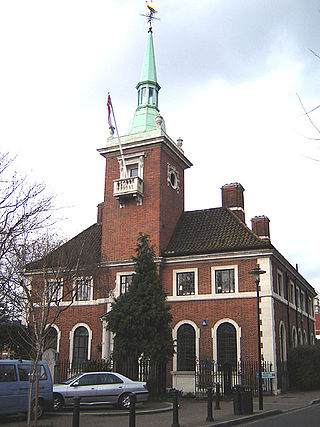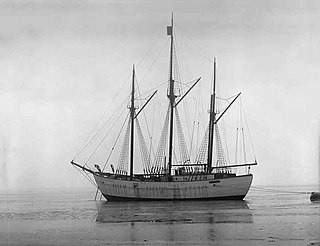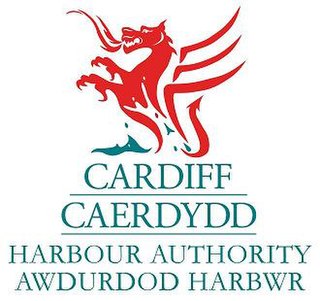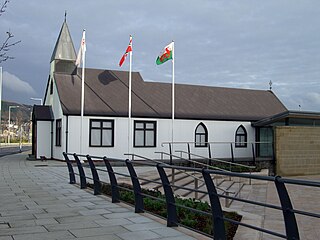
Cardiff is the capital and largest city of Wales. Cardiff had a population of 362,310 in 2021 and forms a principal area officially known as the City and County of Cardiff. The city is the eleventh largest in the United Kingdom. Located in the southeast of Wales and in the Cardiff Capital Region, Cardiff is the county town of the historic county of Glamorgan and in 1974–1996 of South Glamorgan. It belongs to the Eurocities network of the largest European cities. A small town until the early 19th century, its prominence as a port for coal when mining began in the region helped its expansion. In 1905, it was ranked as a city and in 1955 proclaimed capital of Wales. Cardiff Built-up Area covers a larger area outside the county boundary, including the towns of Dinas Powys and Penarth.

Tiger Bay was the local name for an area of Cardiff which covered Butetown and Cardiff Docks. Following the building of the Cardiff Barrage, which dams the tidal rivers, Ely and Taff, to create a body of water, it is referred to as Cardiff Bay. Tiger Bay is Wales’ oldest multi-ethnic community, with sailors and workers from over 50 countries settling there from the mid-19th century onwards.

Cardiff Bay is an area and freshwater lake in Cardiff, Wales. The site of a former tidal bay and estuary, it is the river mouth of the River Taff and Ely. The body of water was converted into a 500-acre (2.0 km2) lake as part of a UK Government redevelopment project, involving the damming of the rivers by the Cardiff Bay Barrage in 1999. The barrage impounds the rivers from the Severn Estuary, providing flood defence and the creation of a permanent non-tidal high water lake with limited access to the sea, serving as a core feature of the redevelopment of the area in the 1990s.

Butetown is a district and community in the south of the city of Cardiff, the capital of Wales. It was originally a model housing estate built in the early 19th century by the 2nd Marquess of Bute, for whose title the area was named. Commonly known as "Tiger Bay", this area became one of the UK's first multicultural communities with people from over 50 countries settled here by the outbreak of the First World War, working in the docks and allied industries. Some of the largest communities included the Somalis, Yemenis and Greeks, whose influence still lives on today. A Greek Orthodox church still stands at the top of Bute Street. It is known as one of the "five towns of Cardiff", the others being Crockherbtown, Grangetown, Newtown and Temperance Town. The population of the ward and community taken at the 2011 census was 10,125. It is estimated that the Butetown's population increased to 14,094 by 2019.

The Norwegian Church Abroad or The Norwegian Seamen’s Church is a religious organisation serving Norwegians and other Scandinavians travelling abroad. Founded in 1864, The Norwegian Seamen's Mission – Sjømannsmisjonen – was established to secure the moral and religious education of Scandinavian seafarers, but also to give them a "breathing room" where a fellow countryman was available to lend an ear and give some attention. Today, the churches and their staff together with travelling pastors around the globe represent a "resource center" for all Norwegians travelling internationally.

The Cardiff Bay Development Corporation was set up by the United Kingdom Government on 3 April 1987 to redevelop one sixth of the area of Cardiff to create Cardiff Bay.

Maud, named for Queen Maud of Norway, was a ship built for Roald Amundsen for his second expedition to the Arctic. Designed for his intended voyage through the Northeast Passage, the vessel was built in Asker, a suburb of the capital, Oslo.

Roald Dahl Plass is a public space in Cardiff Bay, Cardiff, Wales. It is named after Cardiff-born author Roald Dahl, and is located on the coast along the south of the city centre. The square is home to the Senedd building housing the Senedd, the Welsh parliament, and the Wales Millennium Centre, a performing arts centre. The bowl-like shape of the space has made it a popular amphitheatre for hosting open-air concerts.

Cardiff Harbour Authority (CHA) is the managing authority for Cardiff Bay under the Cardiff Bay Barrage Act 1993, and was established on 1 April 2000. It took over responsibility from Cardiff Bay Development Corporation and is responsible for the inland bay, Cardiff Bay Barrage, the outer harbour and the rivers Taff and Ely. The harbour authority is part of the City of Cardiff Council and is the statutory navigation authority for Cardiff Bay.

The timeline of Cardiff history shows the significant events in the history of Cardiff which transformed it from a small Roman fort into the modern capital city of Wales.

The Norwegian Church was a church for Norwegian sailors originally located in Newport, but later relocated to the docklands area of Swansea, Wales. It was a Grade II listed building.
Yemenis in the United Kingdom or Yemeni Britons include citizens and non-citizen immigrants in the United Kingdom of Yemeni ancestry, as well as their descendants. Yemenis have been present in the UK since at least the 1860s, with the first Yemenis arriving as sailors and dock workers in the port cities of Northern England and Wales, and despite a smaller population than other British Muslim groups, are likely the longest-established Muslim group in the United Kingdom, with many of these cities retaining a Yemeni population going back several generations.

Cardiff Docks is a port in southern Cardiff, Wales. At its peak, the port was one of the largest dock systems in the world with a total quayage of almost 7 mi (11 km). Once the main port for the export of South Wales coal, the Port of Cardiff remains active in the import and export of containers, steel, forest products and dry and liquid bulks.

Architecture in Cardiff, the capital city of Wales, dates from Norman times to the present day. Its urban fabric is largely Victorian and later, reflecting Cardiff's rise to prosperity as a major coal port in the 19th century. No single building style is associated with Cardiff, but the city centre retains several 19th and early 20th century shopping arcades.

The Royal Hamadryad Hospital was a seamen's hospital and later a psychiatric hospital in the docklands area of Cardiff, Wales. It had replaced a hospital ship, the former HMS Hamadryad, in 1905. After it closed in 2002 the site was redeveloped for residential use.

All Souls Chapel also known as the Seamen's Institute and later as Merton House was a large chapel which stood at Cardiff Docks, near the present Roald Dahl Plass.

A Sailortown is a district in seaports that catered to transient seafarers. These districts frequently contained boarding houses, public houses, brothels, tattoo parlours, print shops, shops selling nautical equipment, and religious institutions offering aid to seamen; usually there was also a police station, a magistrate's court and a shipping office. Because it took several days, in the past, to unload ships, crews would spend this time in sailortown. These were "generic locations—international everyplaces existing in nearly every port." Cecily Fox Smith wrote that 'dockland, strictly speaking, is of no country—or rather it is of all countries'". Sailortowns were places where local people, immigrants, social and religious reformers, and transitory sailors met.

Eglwys Dewi Sant is a Grade II listed church building in the centre of Cardiff, Wales. It is the only church in the Diocese of Llandaff to conduct its services exclusively in the Welsh language.



















